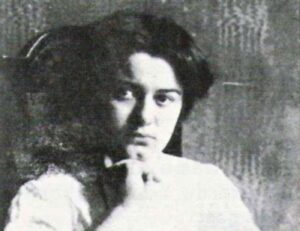Lately, commentators have been asking where the female voices are in the new debates facing American conservatives.
In the New York Times, Helen Andrews started this discussion, asking for “an heir to Phyllis Schlafly, a socially conservative female voice who can galvanize others.” Here at Public Discourse, Luma Simms called for conservative men to listen for and help amplify female conservative voices, while Crisis magazine’s Stephen Krason has argued for a non-feminist reconsideration of women’s social roles.
The Federalist’s Rebekah Curtis offered the most radical response, arguing that the missing Schlafly-figure results from the womanly insight of social conservatives who are “uncertain about the wisdom of a ‘traditional’ woman being very publicly active.” Curtis explicitly invokes the public man–private woman distinction best articulated in Tocqueville’s writing. Still, in their own ways, each of the articles relies on this distinction.
In my opinion, the revival of this distinction is one of the most powerful reasons for conservative women’s comparative silence in political debates. If we are wondering why conservative women are not “showing up,” we should start by revisiting the concept that woman’s nature is uniquely oriented toward private, family-oriented pursuits—and asking whether it’s worth holding on to.
Start your day with Public Discourse
Sign up and get our daily essays sent straight to your inbox.The Gifts of Men and Women
The argument for the public man–private woman distinction asserts that men and women’s natural gifts point them toward distinct spheres of life. In this account, woman’s reproductive capacity and her attachment to her children, in addition to feminine virtues like gentleness, endurance, creativity, and receptivity, best suit her for nurturing home spaces.
By contrast, men are seen as being more oriented toward the public world, with gifts naturally suited for it: thumos, industry, risk-taking, dynamic energy, and so on. Yet family men labor in the world primarily to protect the sacred, dignified interior life of the home, and single men seek to prove themselves professionally to demonstrate that they will be able to become heads of their own domestic domain. Still, fatherhood’s demands, while significant, seem to be more easily met in quality rather than in quantity of time spent with children. This is fortunate, because the demands of labor often remove the man from the home he has to protect.
There is no doubt that there are periods of human history when this division has been considered most ideal, even if it is a luxury only some could partake in, and even if there are reasons to think the account revisionist. There is also little doubt that there is significant canonical praise for it. For example, Tocqueville writes:
Thus, the Americans do not believe that man and woman have the duty or the right to do the same things, but they show the same respect for the role of each one of them, and they consider them as beings whose value is equal, although their destinies differ. They do not give the courage of the woman the same form or the same use as that of the man; but they never doubt her courage; and if they consider that the man and his companion should not always use their intelligence and their reason in the same way, they judge, as least, that the reason of the one is as certain as that of the other, and her intelligence as clear.
By permitting this natural difference, he concludes, the woman is elevated to intellectual and moral equality by a greatness different from the greatness of the man, who—though her equal—retains “the necessary right to command her.”
G.K. Chesterton also focuses on the division of labor, arguing that the woman “is like the fire” that “illuminate[s] and ventilate[s].” To remain aflame, she should be protected from “the direct cruelty of competitive or bureaucratic toil.” Interestingly, he frames his discussion primarily in terms of excellences, labor, and leisure. For example, in story-telling, an art that is essential to the cultivation of children’s moral formation, the woman should not seek out the “startling revelations or the wildest winds of thought,” but should instead repeat stories well with the acuity of a “first-class cook.” The virtuous woman “should have not one trade but twenty hobbies; she, unlike the man, may develop all her second bests. This is what has been really aimed at from the first in what is called the seclusion, or even the oppression, of women.”
Both Tocqueville and Chesterton affirm women’s humanity while emphasizing the importance of keeping our pursuits distinct from male pursuits. For both men, the distinction does not seem to be one of intellectual capacity. Tocqueville emphasizes the quality of American women’s intellectual education prior to marriage, and he depicts them as finding a “kind of glory in the voluntary surrender of their will, . . . locat[ing] their grandeur in bending to the yoke themselves and not in escaping it,” in choosing to deploy their extraordinary powers for the sake of the homestead. A bit differently, Chesterton seems to suggest that women should be removed from the opportunity to cultivate certain excellences for the sake of the oikos, which requires a woman choosing to find contentment with what he calls “her second bests.”
Limiting Women
Like Tocqueville, I think there is an affinity between the domestic life and human excellence; nothing so important to human fulfillment as the oikos could rely on anything less than true excellence. Whether a woman chooses to use her gifts in service of her family by remaining at home, pursuing a profession outside the home, or some combination of the two, the dignity of women’s labor and intellect is not up for debate.
I part from him, however, in his thinking that the public–private distinction is rooted in natural justice. Instead, I would suggest that presenting these two separate spheres for men and women as a moral mandate is unjust, because it conceives of woman in a way that fails to capture the multivalanced quality of our humanity. It ignores the distinctness we possess as individuals.
When we overemphasize the public–private distinction, we limit women’s involvement in the public sphere to a few roles: as a woman who, after fulfilling her true work as a mother by staying home, uses her older years or her precious spare time to turn her significant capacities to the lesser, outer world; as a woman who supports the public pursuits of the men in her life by performing hidden but significant labor; or as a woman who abandons her feminine nature and vocation by pursuing professional work outside of the home—or by forgoing child-bearing in the first place. I do not denigrate the legitimacy of the first two positions, but I do challenge the account of the third role.
The limited roles for women in right-leaning moral and political activity make the re-emergence of socially conservative women as public figures unlikely. They cut the legs out from under women who undertake professional pursuits by subjecting them to categorical moral censure. And should a more “traditional” woman manage the undertaking, she will inevitably rely on the types of things she decries: long periods of childcare, physical absence from the oikos, consummately public engagements and encroachments on the “sphere” of her husband.
In making the world and role of women so rarefied and distinct, the public–private distinction limits women. The problem is not that the private world is lowly and therefore worthy of rejection. Rather, the private and the public are both natural to women—as they are to men—and they are both made better by our presence.
Asking the Right Questions
When it comes to women and work, we often get caught up in asking the same questions over and over. These questions often take a part of women—our reproductive capacity—and substitute it for the whole. It would be like taking a role traditionally identified as male by conservatives—the soldier, for example—and imagining that all men, at all times, and everywhere, are at war, instead of understanding that the capacity for physical defense is one deployed based on context, prudence, need, and individual ability.
Instead, we might ask: What would life look like if we reconfigured social practice to depart from the harshness of the public–private division, imitating something more organic and family-centered? What if workplaces were expected to respond differently to pregnancy, or to the caretaking roles that both men and women can fill for sick relatives or for children?
If a couple believes that the oikos is best served by keeping one parent at home, why should the role-constraint always fall on the woman? What if conservative discourse and practice focused on helping smooth the re-entry of men and women who stay home with young children, so that there is no sharp bifurcation between professional life and home life? What if more professional work might be “taken home” or more professional spaces permitted the presence of young infants? What if interested married couples were encouraged to seek alongside each other the professional and domestic excellences that Chesterton describes, learning together to alternate, share, and privilege a multitude of opportunities and duties? In some ways, conservatism is best situated to suggest these kinds of changes.
Returning to political engagement, if the nature of men and women is best captured by distinctions between universal, gendered, and individual experience, is it right to suggest that women should confine themselves to the private life? It certainly appears many conservatives are learning that it is not useful to take this approach when it comes to topics that disproportionately affect women, such as abortion, modesty, and sexual assault. But what about other topics?
Recent debates about civility might have benefited from women’s intervention. Yet we most likely would not be welcome in this discussion, considering that power, passivity, masculinity, and force were on the line—precisely the kinds of concepts that are associated with a revitalization of masculinity and fatherhood in new conservatism.
It is not only our relevance to certain topics that should make women’s public arguments welcome. Women are humans too, and our roles and talents must be valued for more than the sake of gendered difference. When a man enters the public sphere, he does so not only as a man, but also as a human and individual. Why would it not be the same for women? Our gender differences do not negate our shared humanity. Men and women should act as partners, using our cultivated capacities in search of the good life for all.













